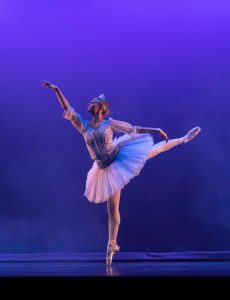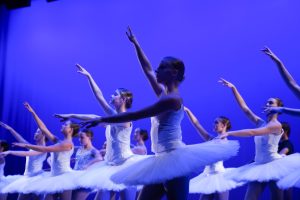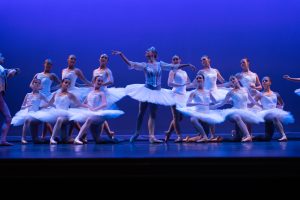By Kara Kuczkowski
As the curtain parts, fog fills the air and a single ballerina steps through the haze. She is beautifully clad in a purple bodice and tutu that twinkles in the stage light. She begins to dance and the fabric bounces with every delicate step. Hours upon hours of work went into making that single costume and, as she glances into the wings, 12 other dancers clad in tutus and bodices wait for their cue.  A costume like the one the Lilac Fairy wore in the recent production of Alabama Repertory Dance Theatre may be constructed for the better part of the semester in The University of Alabama costume shop, but may be worn for less than a total hour in performance. Designed by Tiffany Yeager, Director of Costume Design and Production, the stage was graced with 16 ballerinas and two danseurs in beautiful costumes created for the piece Sleeping Beauty. All 16 ballerinas wore tutus and bodices that were individually stitched for the dancers.Each bodice and tutu was carefully constructed to fit the performers and required custom pieces to be created. “There were ten pieces to a bodice, and each piece had three layers of fabric,” reflected Jillian Gregory who acted as the First Hand for the dance concert. “Multiply that by 13 costumes and the time adds up really quickly.” Gregory and the costume team worked on everything from hand stitching bodices to adding scalloped layers to tutus, and each action had to be repeated on 12 identical costumes.
A costume like the one the Lilac Fairy wore in the recent production of Alabama Repertory Dance Theatre may be constructed for the better part of the semester in The University of Alabama costume shop, but may be worn for less than a total hour in performance. Designed by Tiffany Yeager, Director of Costume Design and Production, the stage was graced with 16 ballerinas and two danseurs in beautiful costumes created for the piece Sleeping Beauty. All 16 ballerinas wore tutus and bodices that were individually stitched for the dancers.Each bodice and tutu was carefully constructed to fit the performers and required custom pieces to be created. “There were ten pieces to a bodice, and each piece had three layers of fabric,” reflected Jillian Gregory who acted as the First Hand for the dance concert. “Multiply that by 13 costumes and the time adds up really quickly.” Gregory and the costume team worked on everything from hand stitching bodices to adding scalloped layers to tutus, and each action had to be repeated on 12 identical costumes.
 Creating costumes for dance requires an intense focus on the movement of the fabric and a dancer’s ability to move while in the costume. While designing costumes for theatre may require the ability to move in a specific scene or action, costumes for dance concerts must be created with the intention to be stretched, bent, and twirled in. “I don’t think people realize how much work goes into each piece,” said Kendall Perry, ARDT’s assistant designer. “A lot goes into it, and the result is beautiful, but they’re only onstage for two to three minutes for three shows.”
Creating costumes for dance requires an intense focus on the movement of the fabric and a dancer’s ability to move while in the costume. While designing costumes for theatre may require the ability to move in a specific scene or action, costumes for dance concerts must be created with the intention to be stretched, bent, and twirled in. “I don’t think people realize how much work goes into each piece,” said Kendall Perry, ARDT’s assistant designer. “A lot goes into it, and the result is beautiful, but they’re only onstage for two to three minutes for three shows.”
Gregory and Perry agreed that the intricate effort was worth it when the concert was finally realized onstage. “The dancers were so genuinely appreciative,” said Gregory. Perry chimed in quickly, saying, “Some of the dancers told me that they had never had a costume made for [them] before. I remember the first time that I had a costume made for me and it was magical. Getting to have that moment [with the dancers] was very special to me.” Both Gregory and Perry emphasized the artistic nature of producing theatre and dance. “My first thought when I saw the tutus in the shop was, ‘That is art. And I get to do that here.’ It’s thrilling,” said Perry. The artistry of live performance lives in the limited run of the production or concert. A beautifully constructed set, floating fabric skirt, and ray of light only exist because of the intricate work of talented designers and technicians behind the scenes. Thank you to all of the designers and technicians that work on UA Theatre and Dance productions!
Both Gregory and Perry emphasized the artistic nature of producing theatre and dance. “My first thought when I saw the tutus in the shop was, ‘That is art. And I get to do that here.’ It’s thrilling,” said Perry. The artistry of live performance lives in the limited run of the production or concert. A beautifully constructed set, floating fabric skirt, and ray of light only exist because of the intricate work of talented designers and technicians behind the scenes. Thank you to all of the designers and technicians that work on UA Theatre and Dance productions!